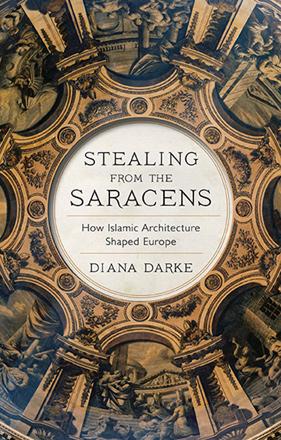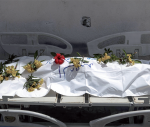You are here
Light, speed, height and beauty
By Sally Bland - Sep 27,2020 - Last updated at Sep 27,2020

Stealing from the Saracens: How Islamic Architecture Shaped Europe
Diana Darke
London: Hurst and Co., 2020
Pp. 447
The irony in the title of this book will not be lost on anyone who knows that the term, Saracens, applied in a derogatory way to Muslims and Arabs, means “people who steal”, for the central theme of Diana Darke’s volume is quite the opposite: that many of the renowned, mediaeval cathedrals in Europe, called Gothic, are based on features and techniques that originated in the eastern Mediterranean.
In this massive cultural importation, minarets became church spires and bell towers in Europe, along with the adoption of other distinctive Middle Eastern architectural features such as stained glass, mosaics, pointed arches, double domes, rose windows and new vaulting methods.
Also ironic is that some promoters of the Gothic style misunderstood its origins. Jerusalem’s iconic Dome of the Rock was copied by the Crusaders, who thought it was Solomon’s Temple, not a Muslim shrine.
Others like Christopher Wren, England’s leading 17th-century architect, recognised that the so-called Gothic style was invented by the Arabs. Its popularity lay in the much greater amount of light allowed into the building, the speed with which such structures could be erected, the heights which they could reach, and the beauty of their ornamentation. These features had religious as well as aesthetic motivation. As Darke writes, “Light streaming in through tall, high windows represented God and His presence, so people instinctively looked upwards and felt their spirits uplifted…” (p. 50)
Darke was inspired to write this book by the 2019 burning of Notre Dame Cathedral in Paris; the discussions about its rebuilding alerted her to the fact that many did not understand the background of its architecture. She, on the other hand, was well-equipped with knowledge to fill in the blanks by virtue of decades spent visiting, researching and living in the Middle East and North Africa, and her extensive writing on cultural themes in the region, especially Syria. Her focus on Syria proved fortuitous as much of the distinctive Islamic architecture was developed during Umayyad rule in Balad Al Sham (Greater Syria), based on Muslim advances in science and geometry in particular. Prior to that was the style evident in early Christian churches still to be seen in Idlib province. “Having been fortunate enough to explore these north Syrian churches many times since the 1970s, most recently in 2010, I believe they constitute a vital and largely unexplored link to the Romanesque churches of Europe… without the missing link of these churches, it is impossible to understand how Hagia Sophia… model for so many later European churches, was built.” (p. 77)
Darke backs up her claims with historical facts and detailed descriptions of hundreds of mosques, churches and other public buildings in the eastern Mediterranean and Europe, so one can see the resemblances and how they developed. Further proof lies in the scores of beautiful colour photographs in the book displaying the buildings in question, from the Great Umayyad Mosque in Damascus to Cordoba’s Mesquita and Venice’s St Mark’s, and even more modern examples of Islamic architectural influence, such as in the works of Le Corbusier and Antoni Gaudi’s Sagrada Familia in Barcelona. Readers can see for themselves how Islamic architectural influence spread, chiefly via Spain, but also Sicily, Venice and Amalfi, on its way to northern Europe, and later even farther afield to the Americas and Australia.
The book is doubly fascinating because Darke embeds her descriptions of architecture in lively, down-to-earth analysis of the social, economic, and cultural conditions under which the churches and mosques were built. While religious fervour was a motivating factor, trade, politics, power struggles and national identity were also at play. For a time, one is drawn into the world of the architects, such as Ottoman Sinan, as well as the master builders and stone masons who carried out the painstaking work needed to create these masterpieces.
While revealing rich, often hidden histories in the Eastern Mediterranean and Europe and their interconnections, Darke also reminds that migration, globalisation and cultural fusion are not only modern phenomena. They have been ongoing for centuries minus the technology one associates with them today. “People moved around in the ancient world, just as they do in the modern world, and usually for the same reasons — war, overpopulation or better economic opportunity… Again and again we are seeing that a strategic trading crossroads like the Middle East was always going to be a multi-cultural, multi-ethnic mix of all the civilisations that had ruled there… each building on the inventions and innovations of the one before, be it through warfare or cooperation.” (p. 99)
Directly and indirectly, Darke argues for history’s continuity and humankind’s interdependence, as well as for inclusion, tolerance and openness. “My purpose has been to show that no one ‘owns’ architecture, just as no one ‘owns’ science… Everything builds on what went before.” (p. 381)
While she shows the devastating consequences of war, in this context most evident in the Crusades, she also gives many examples of how the three monotheistic religions shared common beliefs, aspirations and sometimes even worship space. Cross-fertilisation has resulted in some of the most beautiful structures in the world today, East and West. “No society exists in isolation. If it does and closes in on itself, it will soon die, for lack of stimulation and original thought.” (p. 7)
Related Articles
AMMAN — Origins of the Gothic architecture can be traced back to the Syrian architectural tradition, said author and cultural writer Diana D
The IlluminatorBrenda Rickman VantreaseNew York: St. Martin’s Griffin, 2005Pp.
AMMAN — The Italian embassy in Amman on Wednesday organised a press conference on the situation in Venice, which is reeling from damages cau

















